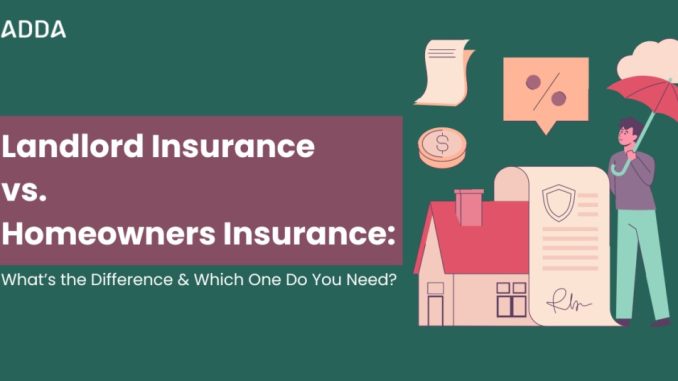
When it comes to protecting real estate investments, understanding the difference between landlord insurance and homeowners insurance is crucial. Though both policies share the goal of safeguarding property, they serve distinctly different purposes and cater to unique risks. For anyone owning a home—whether living in it or renting it out—the nuances between these types of insurance can significantly impact financial security and peace of mind.
At its core, homeowners insurance is designed for individuals who occupy their homes as primary residences. This coverage protects the structure itself, personal belongings, and offers liability protection if someone is injured on the property. It’s a comprehensive safety net tailored to the needs of a family or individual living in their own home. In contrast, landlord insurance is crafted specifically for property owners who rent out their homes or apartments. Since rental properties involve tenants and generate income, the risks are different and often greater, which means the insurance must address those unique challenges.
One of the most fundamental distinctions lies in what each policy covers. Homeowners insurance typically insures the dwelling, other structures on the property like garages or fences, personal possessions inside the home, and liability protection against injuries or accidents. For example, if a tree falls on your house during a storm or your dog bites a guest, homeowners insurance would generally provide coverage for repairs or legal claims. This kind of insurance assumes you live in the home and use it primarily for personal purposes.
Landlord insurance, on the other hand, excludes coverage for the landlord’s personal belongings within the rented unit because the property is considered a business asset rather than a personal residence. Instead, it focuses on protecting the physical structure, the loss of rental income if the property becomes uninhabitable due to damage, and liability coverage that reflects the landlord-tenant relationship. If a tenant slips and falls in the common areas or the rental property sustains damage from a fire, landlord insurance helps cover those costs. Moreover, landlord policies often include protections against risks more common in rental situations, such as tenant-caused damage or legal expenses related to evictions or disputes.
The financial implications of these differences can be significant. For homeowners, insurance premiums are calculated based on factors such as the home’s replacement cost, location, and the personal belongings inside. The coverage limits are designed to restore a family’s living environment and possessions. Meanwhile, landlord insurance premiums reflect the risks inherent in renting to others. Insurers understand that rental properties may face higher wear and tear, occasional non-payment of rent, and potential liability stemming from tenant behavior. Therefore, landlord policies tend to have higher premiums and may include deductibles or exclusions tailored to these realities.
Consider the example of Sarah, who owns a single-family home she recently decided to rent out. When Sarah called her insurance company to switch her policy, she discovered that maintaining a standard homeowners insurance while renting the home could leave her exposed. If a tenant accidentally caused a kitchen fire or damaged the property, her homeowners policy might deny the claim because the property was no longer owner-occupied. By switching to landlord insurance, Sarah secured coverage that not only protects her physical asset but also provides rental income protection should the property be temporarily unlivable.
Liability coverage is another area where the two policies diverge. Homeowners insurance liability protects the resident owner if someone is injured on the premises, but landlord liability must consider additional scenarios such as tenant injuries and even claims related to failure to maintain a safe living environment. Since landlords have a legal duty to keep their property safe, any neglect that leads to tenant injury can result in costly lawsuits. Landlord insurance typically offers liability limits and legal expense coverage that reflect these responsibilities, providing a critical layer of defense.
It’s also worth noting that landlord insurance may cover additional expenses not commonly found in homeowners policies. For example, it can reimburse landlords for the cost of finding new tenants if a renter suddenly vacates, or cover legal fees if eviction proceedings become necessary. While these might seem like minor details, they highlight how landlord insurance adapts to the realities of managing rental properties—a business venture, after all, with its own risks and demands.
Navigating the decision between homeowners insurance and landlord insurance isn’t always straightforward, especially for those transitioning from living in their home to renting it out. It’s essential to communicate openly with insurance providers and understand how policy terms shift based on occupancy and use. Failure to update insurance accordingly can result in denied claims and substantial out-of-pocket costs.
In conclusion, while homeowners insurance and landlord insurance may appear similar on the surface, their distinctions reflect the different realities of living in a home versus renting it out. Homeowners insurance protects the personal sanctuary of the owner, including their belongings and liabilities tied to living there. Landlord insurance, meanwhile, approaches the property as an income-generating asset with associated risks that require specialized coverage. Whether you’re a first-time landlord or a seasoned investor, recognizing these differences and securing the right insurance ensures that your property and financial interests are properly safeguarded, no matter the role you play in the home.